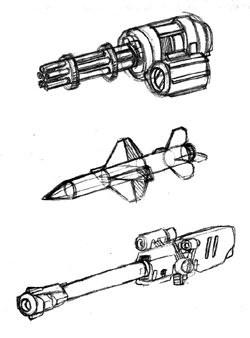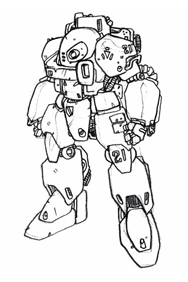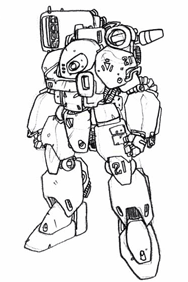|
[w e a p o n s] bringing the big guns to bear
 [one] thing to consider when designing weapon systems to go on your futuristic vehicles and mecha, or designing sidearms for your characters, keep in mind what the weapons would be used for. i feel that this is an important, as the reader (or viewer) can only suspend their disbelief for so long.
[one] thing to consider when designing weapon systems to go on your futuristic vehicles and mecha, or designing sidearms for your characters, keep in mind what the weapons would be used for. i feel that this is an important, as the reader (or viewer) can only suspend their disbelief for so long.
[g u n s] a short essay
[the] laws of physics must be observed when designing weapons. a number of factors should be taken into account. these include weight, payload, recoil and dammage ability. for example. the avenger autocannon mounted on the US military's A10 warthog aircraft is a seven barrelled gattling gun the size of two volkswagon beetles. when firing in sustained bursts, the plane slows in midflight even when full throttle is applied to it's turbofan engines. clearly. a weapon of this sort would break free of any mount if it were attached on a walker, or armoured vehicle.
[for] mecha, i will defer to two anime series which have extremely well designed mecha. these being patlabor, and gundam.
 [in] gundam, typically, a mecha will be armed with a 160mm machine cannon or 180mm beam cannon. the beam cannon feeds power directly from the mobile suit powerplant through feeds in the hand. close in weapon systems are comprised of 60mm vulcans. conversely, in patlabor, you will not see weapons of this calibre. the helldiver labor, of the JSDF mounts a 20mm machine gun. why the difference? consider that vulcans are mounted on static brackets aboard aircraft carriers for close in defence. it fires at an extreme rate, generating more recoil than the hydralically powered labours can handle. in addition, the weight of ammunition required would slow the unit down intollerably. finally, as all labors are lightly armoured, 20mm rounds are more than sufficient in combat.
[in] gundam, typically, a mecha will be armed with a 160mm machine cannon or 180mm beam cannon. the beam cannon feeds power directly from the mobile suit powerplant through feeds in the hand. close in weapon systems are comprised of 60mm vulcans. conversely, in patlabor, you will not see weapons of this calibre. the helldiver labor, of the JSDF mounts a 20mm machine gun. why the difference? consider that vulcans are mounted on static brackets aboard aircraft carriers for close in defence. it fires at an extreme rate, generating more recoil than the hydralically powered labours can handle. in addition, the weight of ammunition required would slow the unit down intollerably. finally, as all labors are lightly armoured, 20mm rounds are more than sufficient in combat.
[why] the big guns in gundam you may ask? anti-ship weapons. although mobile suits can be easily destroyed with the 60mm vulcans alone, large aircraft, ships and spacecraft nececitate larger guns. in addition, mobile suits are designed for space use, as a result, all negative "structural" modifiers for recoil are negated.
[of] course, it's fun to go all out and just design a gun that's helluva big. i mean, go ahead! by all means! i have written this as a guide, but go your own way... and enjoy yourself!
[some] terms
- AP [armour piercing] - these shells are designed to punch through armour, and as a result have pointed tips. this is to concentrate all the kinetic energy in one spot, to maximize armour penetration. the tips are often made of very dense substances such as tungsten or depleted uranium.
- HP [hollow point] - these aren't so much used anymore. they have blunt or hollow heads that deform on impact, alowing a larger surface for kinetic energy to be transfered to the object. these have poor armour piercing ability. [cop killer bullets] - these are regular rounds that have a cross shape filed into their heads so that the force of impact will cause the bullet tip to deform, causing massive trauma.
[v a r i a n t s]
[This] is the part where we get to have some fun. Designing variants is a lot of work, but it's also pretty rewarding. Consider the example RX-22 Wolfhound (see below).
[A] [B]
[B]
[Here] in figure A, we have a standard workhorse mech, a very basic design. Light ceramic armour with 60mm cannon recessed in the forearms. This would be the basic unit on which all variants would be based. I have designated it the Wolfhound "D". Nomenclature is quite unimportant. It's really up to you. The Wolfhound LF variant is armed with a long range sensor scope and targeting system on its left shoulder. On the right is a guided missile rack. This variant would be used for long range support. Another possible variant could be Wolfhound "R" armed with a hand held 120mm cannon, making it a standard infantry model, or a Wolfhound "P" with an orbital drop pack and parachute... The choices are almost infinite.
[ up one level ]
Version 6.4 © 1998-1999 Studio Mica. Made with editPAD™
|